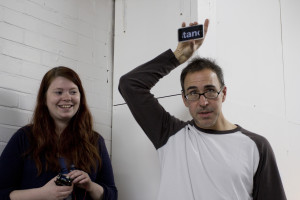Had a great discussion about this, with Spike Island director & comms mgr, continued later at Pervasive Media Studio during our Open House there. This led to one of my conclusions about the residency: when it comes to embedding digital in arts organisations, ‘computational thinking’ is the wrong term; it’s less about technological things than about practices and processes.

Linda & Kevin & i-device
Google’s brand of computational thinking involves breaking down a problem, looking for patterns in the data, generalising/abstracting, then developing algorithmic solutions. Now straight away you can see that this is a Google-centric approach, geared toward big datasets and a sort of engineering mindset. It assumes you have a well-defined problem, can rigorously collect lots of useful data, and either have the time to go through it, or can adequately instruct a computer to do so. Not even coming to the bit at the end about devising an algorithm.
Instead of trying to think like a computer, consider the opposite approach. Maybe your problem isn’t well-defined, or it’s a question or exploration or idea rather than a problem. Maybe instead of breaking it down into discrete steps, you build it up, serendipitously, pulling from disparate, sometimes unexpected, sources. Maybe it is derived from a pattern, or comes together in something we immediately recognise as a pattern. Maybe you don’t want to create instructions to be able to replicate it again and again; you want each outcome to be unique, contextualised. This is roughly the process of making art. Or curating an art exhibition.
We explored the distinction between rational and intuitive thinking in the workshops we ran; this comes from psychologist Daniel Kahnemann. We took up Spike Island’s challenge to break down walls and make things visible, approaching it using computational thinking. Breaking down the problem, we first wanted to find out about activity in different parts of the building, and we collected data about movement, information-seeking behaviour, collaboration and communication. Some patterns emerged – time-based cycles of activity for example, and spaces where people went to meet and collect information. (Perhaps not) coincidentally, Google Analytics makes it easy to collect such statistics about the Spike website; could we do the same for the physical space? It requires collecting data at key times and spaces (or at all times and spaces, if you have Google-sized resources). Then plotting and analysing, before generalising and programming.
Is there a middle ground between rational and intuitive, computational and creative? Maybe. Design patterns are a bit like computational thinking; they’re a similarly ordered set of steps to frame and share creative solutions. The problem comes first, framed in its typical context; then a solution, with cross-references to other patterns. It may or may not be informed by lots of data (many examples of the problem in the wild).
The common thing in all those approaches is patterns. This is the part that humans are much better at than machines. “We are hardwired to gain control of a situation by recognising patterns, even if they ignore current rationale” (says Shing-Tat Chung in a fascinating RCA project last year). It’s “about moving people into the thought space that an algorithm could operate with a very humane way of working.”
In other words, make computers intuitive, by breaking them apart, soldering them together, planting them into spaces and things, then programming those spaces and things. Arts organisation as computing platform, with open data for various applications.

